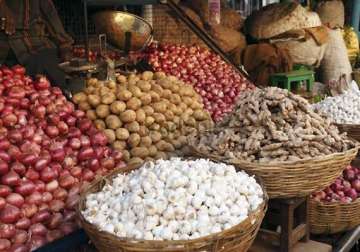Driven by rise in the prices of vegetables and pulses, the Consumer Price Inflation index (CPI) rose to about five-and-half year high of 7.35% in December 2019, crossing the upper comfort limit of Reserve Bank of India (RBI). The latest retail inflation figures are at highest after July 2014 and crossed 6% mark for the first time after 2016 in the Modi regime.
Vegetables, pulses price key contributor to food price index leading to retail inflation to a 5-year high record
- This is for the first time after July 2014 when overall retail inflation has reached to 7.4% and also the first time after 2016 when it is above 6%.
- Food price index rose to 14.1% in the last month becoming a major contributor to the retail inflation mainly due to the soaring prices of onions and pulses, meat, fish, others.
- The inflation in 'pulses and products' was recorded at 15.44%, while in case of 'meat and fish' it was nearly 10%.
- Though the food price index contributed majorly to inflation, it is mainly due to the rise in the prices of onions and pulses.
Inflation on a 5-year high: What it means
- With retail inflation on a 5-year high level, it has diminished the chances of the RBI cutting interest rate at its next monetary policy review due on February 6.
- The CPI inflation has breached RBI Monetary Policy Committee (MPC) target of 6% for the first time in the last 41 months.
- Inflation in rural areas was recorded at 7.3% while in Urban places it was 7.5%, therefore the overall inflation in 2019 stood at 7.4%.
- However, in November, the retail inflation stood at 5.5%, slightly below then the upper limit of RBI's comfort level.
- However, economists believe that inflation may come down in the coming months once the onion prices reach a comfort zone.
- The overall retail inflation based on Consumer Price Index (CPI) was 2.11% in December 2018 and 5.54% in November 2019.
- As per the National Statistical Office (NSO), the overall food inflation rose to 14.12% in December as against (-) 2.65% in the same month of 2018. The food inflation was 10.01% in November 2019.
- The previous high in retail inflation was witnessed at 7.39% in July 2014, the year Narendra Modi-led government assumed office for the first term.
- The central government has mandated the Reserve Bank of India to keep inflation in the range of 4% with a margin of 2% on the either side.
- The RBI, which mainly factors in the CPI-based inflation, is scheduled to announce its next bi-monthly monetary policy on February 6.
- In its December policy, the central bank, which has been reducing rates, had kept the repo rate unchanged citing inflationary concerns.
- Even though analysts expect the headline CPI inflation to correct sharply in January 2020 and further in February 2020, from the unpalatably high 7.35% recorded in December 2019, it is expected to remain sticky above 4.3% in the next few quarters.
- Commenting on the latest number, industry body PHD Chamber said the rise in inflation rate is not sustainable and the average inflation should remain at around 5.5% for the current financial year.
ALSO READ: High inflation to complicate growth issues: analysts say, warning of stagflation
ALSO READ: Retail inflation rises to 5-yr high of 7.35 percent in December, surpasses RBI's comfort level
Latest Business News
